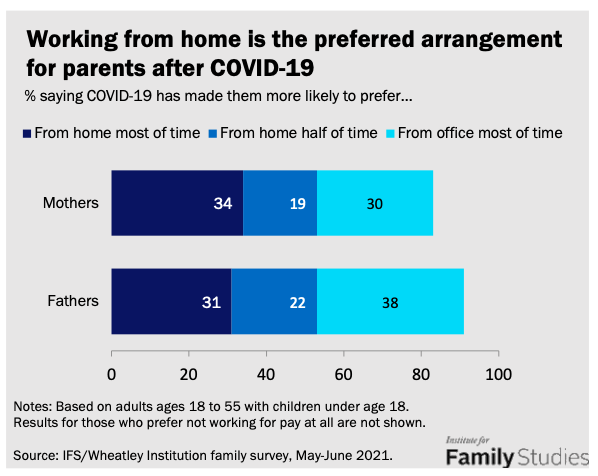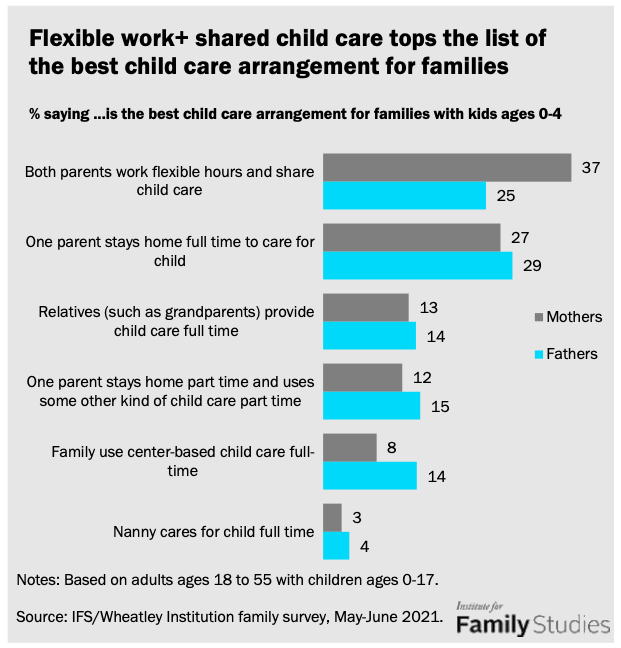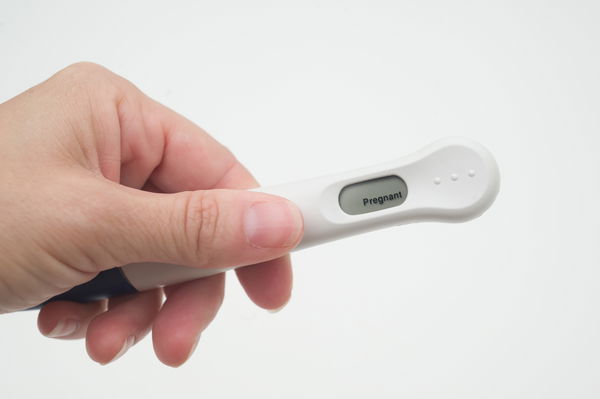Highlights
- More than half of parents with children under age 18 said that COVID-19 has made them more likely to prefer working from home, either most of the time (33%) or half of the time (20%), per a new IFS/Wheatley Institution report. Post This
- Parents rated “both parents work flexible hours and share child care” as the best child care arrangement for families with kids ages 0-4. Mothers were more likely than fathers to prefer that option (37% vs. 25%). Post This
Despite all the chaos and struggles over the past year, the fallout from the COVID-19 pandemic gave many parents the first-hand experience of working from home. And they like it.
Indeed, the possibilities in workplace flexibility created during the coronavirus crisis may have begun a reset in the way parents think about what they want in their work and family lives—a reset that looks “homeward bound.” More than half of parents with children under age 18 said that COVID-19 has made them more likely to prefer working from home, either most of the time (33%) or half of the time (20%), according to a new Institute for Family Studies/Wheatley Institution survey by YouGov.
These feelings are shared by both mothers and fathers. Over half of fathers said the coronavirus pandemic has made them more likely to prefer working from home (either full or part time), while only 38% said that the impact of COVID-19 made them more likely to want to work from the office.
Similarly, only 30% of mothers said the pandemic made them more likely to prefer working from the office most of the time. A majority (53%) of mothers would prefer to work from home most or half of the time. This question was asked of parents who said that their ideal situation was to work. The rest of the parents (18% of moms and 8% of dads) said they simply prefer to not work for pay at all.

Some of this shift in desire reflects the fact that parents now see more options for possible ways to arrange child care. In the same survey, parents rated “both parents work flexible hours and share child care” as the best child care arrangement for families with kids ages 0-4. Mothers were more likely than fathers to prefer that option (37% vs. 25%). Having a stay-at-home parent is still popular among parents, with close to 30% of mothers and fathers believing that “one parent stays home full time to care for child” is the best arrangement for families with kids under age 5.
On the other hand, full-time center-based child care, the arrangement most often discussed in public policy proposals, was only favored by 11% of parents. Fathers were more likely than mothers to list full-time center-based care as the best arrangement for families with young kids (14% vs. 8%).

Working mothers, especially those who work full-time, were the group most likely to prefer the model of “flexible work plus shared child care.” More than four-in-ten mothers who work full-time endorsed this arrangement (42%), while 22% said one parent staying home to care for the child is best. Only 11% of full-time working mothers said using center-based child care full time is the best arrangement for families with children under age 5.
These findings are based on a new Institute for Family Studies/Wheatley Institution survey of 2,500 American adults ages 18-55, which was conducted May 28 to June 10, 2021, by YouGov.
Other key findings from the report include:
- The pandemic has changed many parents’ preference in terms of working full time, part time, or not working for pay at all. Fathers and mothers were equally likely to say the pandemic has changed their preferences, with a particular shift toward part-time work among certain groups. College-educated mothers were much more likely than non-college educated mothers to say COVID-19 has made them more likely to prefer part-time work (17% vs. 11%). On the other hand, COVID-19 also makes part-time work more appealing for non-college educated fathers (15%) than college-educated fathers (5%).
- When it comes to working from home versus the office, college-educated fathers take the lead in endorsing working from home. A total of 65% of college-educated fathers said the pandemic made them prefer working from home either most of the time (44%) or half of the time (21%). The share is 45% for non-college educated fathers and 57% for college-educated mothers. College-educated fathers were also the group least likely to say they prefer not working for pay at all.
- For parents with children under age 5, a gap in the ideal versus reality exists mainly in two types of child care arrangements: “flexible work + shared child care” and the stay-at-home parent model. Some 30% of parents of young children said the best child care arrangement is having both parents work flexible hours and share child care, but only 18% of them currently use this arrangement. Meanwhile, the share of families with young children who currently have a full-time stay-at-home parent is higher than the share that believes having a parent at home full-time is the best child care arrangement (40% vs. 28%).
- Most families who currently have a stay-at-home parent (57%) are practicing what they believe is the best arrangement for their families. Some families with children under age 5 who currently have one parent at home full-time do have a desire for more paid work. However, instead of sending their kids to day care full time (8%), these parents were more likely to prefer working flexible hours and sharing child care responsibilities (23%).
Download the full IFS/Wheatley Institution research brief here.














